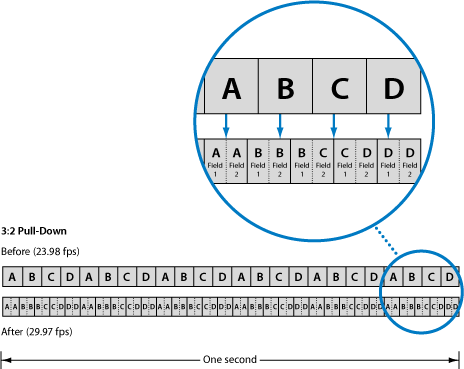Some notes about the DV video format (always interlaced!) with 3:2 pulldown:
Most explanations that indicate how 2:3:2:3 frames are laid out are misleading or even wrong, especially for DV.
If you think of four progressive film frames as:
[A] [B] [C] [D]
what DV needs to do is "telecine" -- turn the 24P (from the camera sensor) into 60i to record to DV format.
So it needs to take those four full frames and make 10 half frames.
(Repeat that 6 times, and you have taken one second of 24 progressive (full frame) fps (frames per second)
and created one second of 60 half frame fields!)
If we split those frames into (starting at 0) even lines and odd lines (ie: fields), we get:
[A0 A1] [B0 B1] [C0 C1] [D0 D1]
Most explanations gloss over some explanation like: A0 A1 A1 B0 B1 C0 C1 C1 D0 D1
But this is not how the fields (1/2 frames) are laid out on tape!
It depends a bit on your camera (there area few ways to write them out), but for our
DV example above, they are written out like:
[A0 A1] [B0 A1] [C0 B1] [C0 C1] [D0 D1]
That strikes us both as *quite* weird and totally unexpected, right?
If you look a bit closer, it makes more sense -- the A1 field is repeated
in the same spot visually (the odd lines in 2 adjacent frames),
and so is the C0 field. You can see this very clearly by stepping thru
the sample set and hitting NEXT PAIR four times.
You see as you step through them:
[good pairing] [bad pairing] [bad] [good] [good]
You can see a pair of duped fields (1 and 3) easily by clicking
here
and then trying the "SWAP TOP/BOTTOM" link. Notice how nothing visually changes!
So the way one would "pullup" four progessive 24 fps frames from that DV encoding would be:
(if the A0 is the field=0; B0 is field=2; and so on...)
* throw out the 3rd (A1 dupe) and 4th (C0 dupe) fields
* basically re-merge the B0 and B1 fields back into a [B] frame
* merge the remaining pairs of fields into [A] [C] [D]
Click to step through the
deinterlaced solution
(then click "NEXT PAIR" until done)
Your "cadence" of "3 good, 2 bad" may start at a slightly different point that the DV sample above,
but the standard telecine pattern for DV will either be the same
(or can be an alternate repeatable pattern of 10 fields from 4 frames).
Best documentation I could find (from Cinema Tools) for 2:3:2:3 pulldown
with an *alternate* way to explain the cadence:
 It's a bit confusing for DV, since:
* DV starts 2 fields in from this
* if you look carefully, it can make you think [C] is field swapped
(compared to [A] [B] and [D])
So I find my detected and explained cadence pattern above more apropos for DV!
But YMMV 8-)
It's a bit confusing for DV, since:
* DV starts 2 fields in from this
* if you look carefully, it can make you think [C] is field swapped
(compared to [A] [B] and [D])
So I find my detected and explained cadence pattern above more apropos for DV!
But YMMV 8-)
 It's a bit confusing for DV, since:
* DV starts 2 fields in from this
* if you look carefully, it can make you think [C] is field swapped
(compared to [A] [B] and [D])
So I find my detected and explained cadence pattern above more apropos for DV!
But YMMV 8-)
It's a bit confusing for DV, since:
* DV starts 2 fields in from this
* if you look carefully, it can make you think [C] is field swapped
(compared to [A] [B] and [D])
So I find my detected and explained cadence pattern above more apropos for DV!
But YMMV 8-)